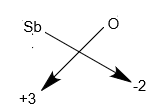
Write the chemical formula for the zinc acetate and antimony trioxide.
Answer
426.6k+ views
Hint: Chemical formula: A set of chemical symbols representing the elements and their respective proportions in a chemical compound. Chemical formula of a compound can be written by using the respective valencies of an atom or formal charge of molecules comprising the compound.
Complete answer:
The chemical formula can be written according to the steps which are as follows:
1.Zinc Acetate
Step-1: Write down the symbols of element, ion or molecules used in the compound:
Symbol for Zinc atom
Symbol for acetate ion
Step-2: Write down the valency of elements or formal charge of molecules used.
Valency of zinc atom: The valence shell of zinc i.e.,
Acetate ion already exists in its ionic form, so there is no need to calculate any formal charge for it.
Step-3: The chemical formula is written according to the cross-multiplication rule.

Hence, the chemical formula of the zinc acetate is
1.Antimony trioxide
Step-1: Write down the symbols of element, ion or molecules used in the compound:
Symbol for antimony atom
Symbol for oxygen ion
Step-2: Write down the valency of elements or formal charge of molecules used.
Valency of antimony atom: The valence shell of antimony i.e.,
Valency of oxygen atom: The valence shell of oxygen i.e.,
Step-3: The chemical formula is written according to the cross-multiplication rule.

Hence, the chemical formula of the antimony trioxide is
Note:
The electropositive element i.e., element having positive valency is always symbolized before the electronegative element i.e., element with negative charge. In the suffix of the symbols, charge is never mentioned, only magnitude of the valency is written.
Complete answer:
The chemical formula can be written according to the steps which are as follows:
1.Zinc Acetate
Step-1: Write down the symbols of element, ion or molecules used in the compound:
Symbol for Zinc atom
Symbol for acetate ion
Step-2: Write down the valency of elements or formal charge of molecules used.
Valency of zinc atom: The valence shell of zinc i.e.,
Acetate ion already exists in its ionic form, so there is no need to calculate any formal charge for it.
Step-3: The chemical formula is written according to the cross-multiplication rule.

Hence, the chemical formula of the zinc acetate is
1.Antimony trioxide
Step-1: Write down the symbols of element, ion or molecules used in the compound:
Symbol for antimony atom
Symbol for oxygen ion
Step-2: Write down the valency of elements or formal charge of molecules used.
Valency of antimony atom: The valence shell of antimony i.e.,
Valency of oxygen atom: The valence shell of oxygen i.e.,
Step-3: The chemical formula is written according to the cross-multiplication rule.

Hence, the chemical formula of the antimony trioxide is
Note:
The electropositive element i.e., element having positive valency is always symbolized before the electronegative element i.e., element with negative charge. In the suffix of the symbols, charge is never mentioned, only magnitude of the valency is written.
Recently Updated Pages
Master Class 11 Economics: Engaging Questions & Answers for Success

Master Class 11 Business Studies: Engaging Questions & Answers for Success

Master Class 11 Accountancy: Engaging Questions & Answers for Success

Master Class 11 English: Engaging Questions & Answers for Success

Master Class 11 Computer Science: Engaging Questions & Answers for Success

Master Class 11 Maths: Engaging Questions & Answers for Success

Trending doubts
State and prove Bernoullis theorem class 11 physics CBSE

What are Quantum numbers Explain the quantum number class 11 chemistry CBSE

Write the differences between monocot plants and dicot class 11 biology CBSE

Why is steel more elastic than rubber class 11 physics CBSE

Explain why a There is no atmosphere on the moon b class 11 physics CBSE

1 ton equals to A 100 kg B 1000 kg C 10 kg D 10000 class 11 physics CBSE




